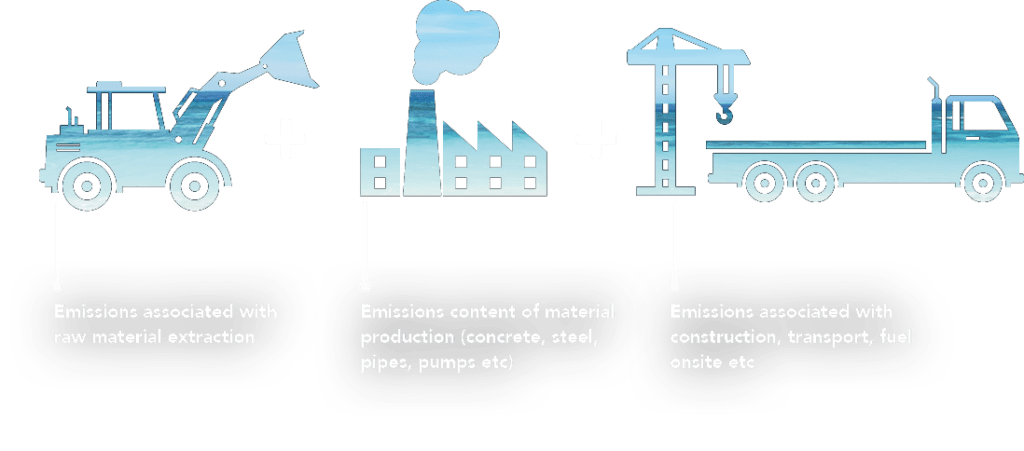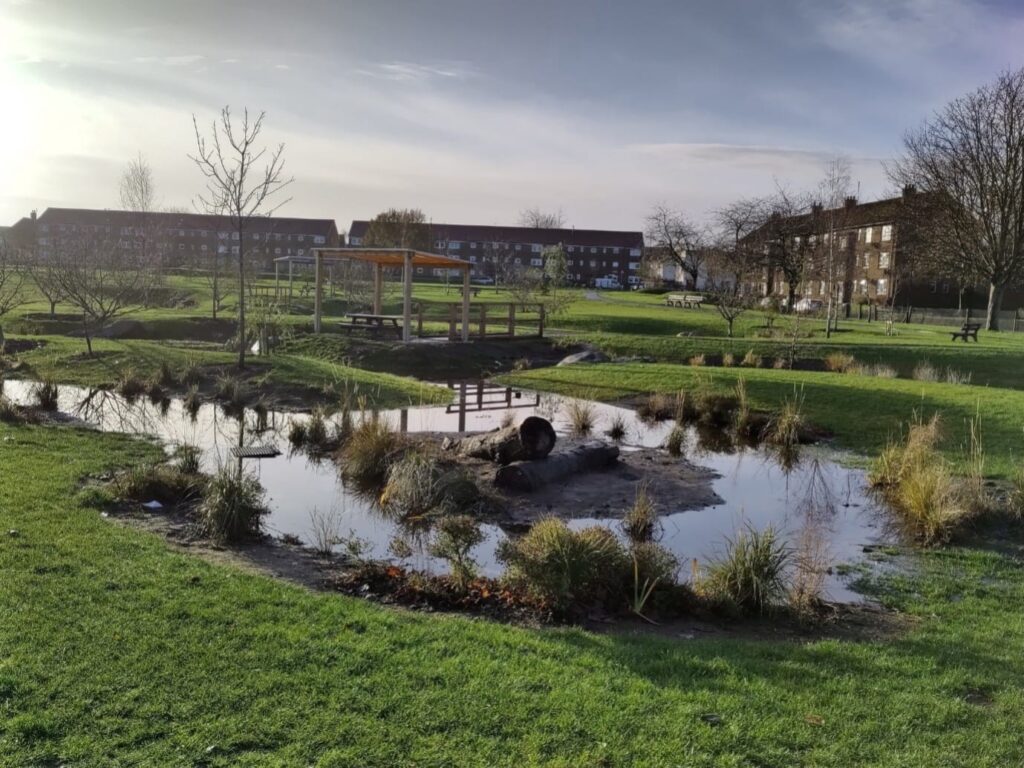Scottish Water is committed to transforming the way it operates and invests to deliver net zero emissions by 2040.
In this section you can find out more about the commitment we have made, the principles we will apply to guide our approach and our overarching objectives which will help deliver our purpose of Supporting a Flourishing Scotland.
DECLARATION OF CLIMATE EMERGENCY,
CLIMATE CHANGE ACT

CLIMATE CHANGE
Climate change is an existential threat to the wellbeing of future generations as it impacts the environment on which we all depend, and we must all play our part in limiting its adverse impacts. We rely on a good quality environment for the provision of our vital services.
At the heart of our response to the declaration of a climate emergency is the ambition we have set to achieve net zero emissions by 2040, 5 years ahead of the Scottish Government’s target and then going beyond it.
To plan for the resilience of our services in the future, as set out in our strategic plan, we have developed a parallel set of activities that focus on climate change adaptation.
TO ACHIEVE OUR NET ZERO
EMISSIONS AMBITION, WE WILL:
USE LOWER-CARBON
ENERGY PRODUCTS
We are an emission-intensive business, meaning our current emission footprint is large. We have two major contributors to our emissions: operational emissions from the delivery of our vital services and investment emissions driven by our investment programme that maintains and improves our services.
We have been working hard, year on year, to reduce our emissions by using more efficient equipment, reducing leaks from our water pipes, and through using solar, hydro and wind power. This has meant that, since 2007, we have nearly halved the emissions from our operations.
Currently, our operational emissions are over
254,000 tCO2e* each year, the equivalent of
up to 40,000 car journeys around the world.
Whilst the challenge ahead of us is big, we have the
experience, ambition and commitment to overcome it.
*Tonnes carbon dioxide equivalent per annum
Currently, our operational emissions are over 254,000 tCO2e* each year, the equivalent of up to 40,000 car journeys around the world.
Whilst the challenge ahead of us is big, we have the experience, ambition and commitment to overcome it.
*Tonnes carbon dioxide equivalent per annum
Currently, our operational emissions are over 254,000 tCO2e* each year, the equivalent of up to 40,000 car journeys around the world.
*Tonnes carbon dioxide equivalent per annum


In this section you’ll find out more about our current emissions and the progress we have made so far towards net zero.
In this section you’ll find out more about our current emissions and the progress we have made so far towards net zero.
CARBON INTENSITY OF OUR SERVICES
WASTEWATER
Our water service has one of the
lowest carbon intensities in the UK.
CARBON INTENSITY OF OUR SERVICES
WATER
WASTEWATER
Our water service has one of the
lowest carbon intensities in the UK.*
*From industry benchmarking
45%
53GWh
831GWh
REDUCTION IN OPERATIONAL EMISSIONS SINCE 2007
OF RENEWABLE ENERGY PRODUCED AND USED ANNUALLY ON OUR SITES
45%
REDUCTION IN OPERATIONAL EMISSIONS SINCE 2007
53GWh
OF RENEWABLE ENERGY PRODUCED AND USED ANNUALLY ON OUR SITES
831GWh

OUR EMISSIONS FOOTPRINT
Our operational emissions are calculated using the water sector carbon accounting workbook* and are independently verified. They cover what are termed Scope 1, 2 and 3 emissions:
Scope 1 – Direct emissions: onsite combustion of fossil fuels; process emissions; and emissions from vehicles owned or leased by Scottish Water.
Scope 2 – Indirect emissions: use of grid electricity.
Scope 3 – Indirect emissions: business travel by public transport and private vehicles; outsourced activities including sites run by PFI companies.
*UK Water Industry Research Ltd Carbon Accounting Workbook
As well as operational emissions, our investment activities also generate emissions.
From the extraction of raw materials from the ground all the way to the delivery of a project on site, there are emissions released at every step of the way. Regardless of where these come from in the world and who produces them, we will account for them and work hard to drive them down.

However, this isn’t easy. Investment emissions are challenging to accurately measure and record, meaning it can be difficult to manage them effectively.
Because of this we have developed our Capital Carbon Accounting Tool through which we can plan, measure and report the emissions driven by our supply chain activity. This means that when options for a project are developed, our teams can now calculate the emissions impact and use this to make better decisions, with a focus on lower emission options.
We are developing a new metric – the carbon intensity of investment – to bring focus to this area. Our current understanding is that this sits in the range of 200-300 tCO2e/£m of investment.
By knowing where these emissions are coming from in the supply chain, we can take steps to reduce them, helping us and our supply chain towards net zero emissions.
OUR ROUTEMAP TO NET ZERO EMISSIONS
Our routemap starts from where we are now, our knowledge and understanding of what can be done with what we know today, and sets out a journey to net zero emissions.

IN THE ROUTEMAP, WE HAVE ESTABLISHED THREE MILESTONES ON OUR JOURNEY TO NET ZERO
2025
2030
2040
We will reduce our operational emissions by at least 60%*. We will progress reducing our investment emissions, growing our understanding, and will set a reduction goal for 2030.
*from 2007 baseline (read more here)
We will reduce our operational emissions by at least 75%* in line with Scottish Government targets.
We will achieve net zero emissions and will be supporting Scotland to achieve its goal of net zero emissions.
IN THE ROUTEMAP, WE HAVE ESTABLISHED THREE MILESTONES ON OUR JOURNEY TO NET ZERO
2025
We will reduce our operational emissions by at least 60%*. We will progress reducing our investment emissions, growing our understanding, and will set a reduction goal for 2030.
2030
We will reduce our operational emissions by at least 75%* in line with Scottish Government targets.
2040
We will achieve net zero emissions and will be supporting Scotland to achieve its goal of net zero emissions.
*from 2007 baseline (read more here)
To get to net zero emissions will require the help of others.
There are many actions we can take to reduce the emissions which are directly under our control, for example, making our wastewater treatment works more energy efficient, reducing leakage or using our land to host renewable energy or to store away carbon.
Other emissions require us to influence customers, partners and supply chains, for example, the amount of water people use, the removal of surface water from our sewers or the emissions in the cement we buy.
And for some emissions we will take the opportunities that come from development of new technologies, such as low energy lighting or zero emission vans and tankers.
But we can also help others and can make a significant contribution to a Flourishing Scotland by supporting university research, helping develop the workforce of the future, the low carbon construction sector and looking at how our assets and resources can help reduce Scotland’s emissions. For example, by growing Scotland’s natural capital and supporting the hydrogen economy.
INTRODUCTION

TRANSFORMATION



ELECTRICITY

PROCESS
EMISSIONS

GAS &
FUEL OIL

TRANSPORT
& TRAVEL

INVESTMENT

STORING
CARBON
Scottish Water has established a framework for the supply of sustainably sourced hydrotreated vegetable oil that can be used by both Scottish Water and its construction partners. It’s a drop in fuel replacement that reduces emissions by 90% compared to conventional diesel.
Over the last year it has been widely adopted by our construction partners, displacing diesel use in excavators, cranes and other heavy plant. It is also being used to fuel generators to provide power for remote construction sites.
On our water mains rehabilitation programme its adoption is expected to reduce emissions by nearly 30%.
Scottish Water has been a partner in a project, led by the local community and supported by the National Lottery’s Community Fund, to regenerate the site once occupied by Douglas Primary School as a multi-functional greenspace.
Our team worked with the community to incorporate sustainable drainage features in the new park, which store and slowly release the rainwater that falls on surrounding roads and rooftops during storms. This eases pressure on the combined sewer network in the local area, as well as helping to protect the local environment and reduce flood risk from the Dighty Burn. Importantly, the community has been able to realise its wider aims by creating an attractive outdoor space that also provides a home for wildlife; and can be enjoyed for play, relaxation, exercise, events and the growing of food.

Planning is now underway to introduce more sustainable water management measures in the area surrounding the park, with the aim of disconnecting over 40,000m2 of land area from the combined sewer network; and helping to enable the development of more social housing in Douglas. Engagement with the community, including schools and other key stakeholders, is being carried out to help shape the proposals.
Work with the community and Dundee City Council on sustainable drainage for Douglas has helped to inspire the Water Resilient Dundee partnership. This initiative is now pursuing opportunities for more sustainable management of stormwater across the city, reducing flood risk in communities, creating capacity for development and enhancing amenity.